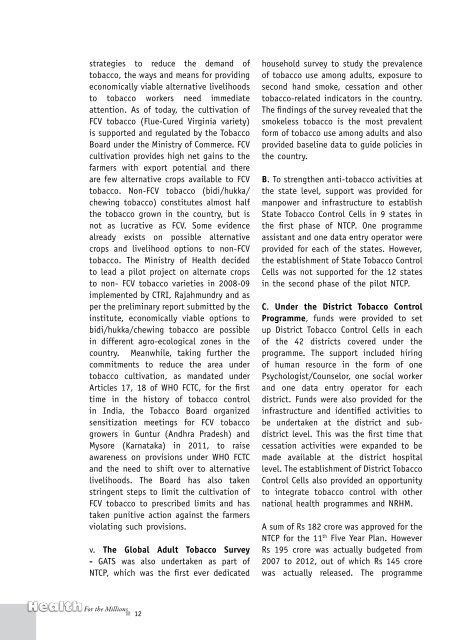Breaking New Grounds in Tobacco Control - Voluntary Health ...
Breaking New Grounds in Tobacco Control - Voluntary Health ...
Breaking New Grounds in Tobacco Control - Voluntary Health ...
You also want an ePaper? Increase the reach of your titles
YUMPU automatically turns print PDFs into web optimized ePapers that Google loves.
strategies to reduce the demand of<br />
tobacco, the ways and means for provid<strong>in</strong>g<br />
economically viable alternative livelihoods<br />
to tobacco workers need immediate<br />
attention. As of today, the cultivation of<br />
FCV tobacco (Flue-Cured Virg<strong>in</strong>ia variety)<br />
is supported and regulated by the <strong>Tobacco</strong><br />
Board under the M<strong>in</strong>istry of Commerce. FCV<br />
cultivation provides high net ga<strong>in</strong>s to the<br />
farmers with export potential and there<br />
are few alternative crops available to FCV<br />
tobacco. Non-FCV tobacco (bidi/hukka/<br />
chew<strong>in</strong>g tobacco) constitutes almost half<br />
the tobacco grown <strong>in</strong> the country, but is<br />
not as lucrative as FCV. Some evidence<br />
already exists on possible alternative<br />
crops and livelihood options to non-FCV<br />
tobacco. The M<strong>in</strong>istry of <strong>Health</strong> decided<br />
to lead a pilot project on alternate crops<br />
to non- FCV tobacco varieties <strong>in</strong> 2008-09<br />
implemented by CTRI, Rajahmundry and as<br />
per the prelim<strong>in</strong>ary report submitted by the<br />
<strong>in</strong>stitute, economically viable options to<br />
bidi/hukka/chew<strong>in</strong>g tobacco are possible<br />
<strong>in</strong> different agro-ecological zones <strong>in</strong> the<br />
country. Meanwhile, tak<strong>in</strong>g further the<br />
commitments to reduce the area under<br />
tobacco cultivation, as mandated under<br />
Articles 17, 18 of WHO FCTC, for the first<br />
time <strong>in</strong> the history of tobacco control<br />
<strong>in</strong> India, the <strong>Tobacco</strong> Board organized<br />
sensitization meet<strong>in</strong>gs for FCV tobacco<br />
growers <strong>in</strong> Guntur (Andhra Pradesh) and<br />
Mysore (Karnataka) <strong>in</strong> 2011, to raise<br />
awareness on provisions under WHO FCTC<br />
and the need to shift over to alternative<br />
livelihoods. The Board has also taken<br />
str<strong>in</strong>gent steps to limit the cultivation of<br />
FCV tobacco to prescribed limits and has<br />
taken punitive action aga<strong>in</strong>st the farmers<br />
violat<strong>in</strong>g such provisions.<br />
v. The Global Adult <strong>Tobacco</strong> Survey<br />
- GATS was also undertaken as part of<br />
NTCP, which was the first ever dedicated<br />
For the Millions<br />
n 12<br />
household survey to study the prevalence<br />
of tobacco use among adults, exposure to<br />
second hand smoke, cessation and other<br />
tobacco-related <strong>in</strong>dicators <strong>in</strong> the country.<br />
The f<strong>in</strong>d<strong>in</strong>gs of the survey revealed that the<br />
smokeless tobacco is the most prevalent<br />
form of tobacco use among adults and also<br />
provided basel<strong>in</strong>e data to guide policies <strong>in</strong><br />
the country.<br />
B. To strengthen anti-tobacco activities at<br />
the state level, support was provided for<br />
manpower and <strong>in</strong>frastructure to establish<br />
State <strong>Tobacco</strong> <strong>Control</strong> Cells <strong>in</strong> 9 states <strong>in</strong><br />
the first phase of NTCP. One programme<br />
assistant and one data entry operator were<br />
provided for each of the states. However,<br />
the establishment of State <strong>Tobacco</strong> <strong>Control</strong><br />
Cells was not supported for the 12 states<br />
<strong>in</strong> the second phase of the pilot NTCP.<br />
C. Under the District <strong>Tobacco</strong> <strong>Control</strong><br />
Programme, funds were provided to set<br />
up District <strong>Tobacco</strong> <strong>Control</strong> Cells <strong>in</strong> each<br />
of the 42 districts covered under the<br />
programme. The support <strong>in</strong>cluded hir<strong>in</strong>g<br />
of human resource <strong>in</strong> the form of one<br />
Psychologist/Counselor, one social worker<br />
and one data entry operator for each<br />
district. Funds were also provided for the<br />
<strong>in</strong>frastructure and identified activities to<br />
be undertaken at the district and subdistrict<br />
level. This was the first time that<br />
cessation activities were expanded to be<br />
made available at the district hospital<br />
level. The establishment of District <strong>Tobacco</strong><br />
<strong>Control</strong> Cells also provided an opportunity<br />
to <strong>in</strong>tegrate tobacco control with other<br />
national health programmes and NRHM.<br />
A sum of Rs 182 crore was approved for the<br />
NTCP for the 11 th Five Year Plan. However<br />
Rs 195 crore was actually budgeted from<br />
2007 to 2012, out of which Rs 145 crore<br />
was actually released. The programme


